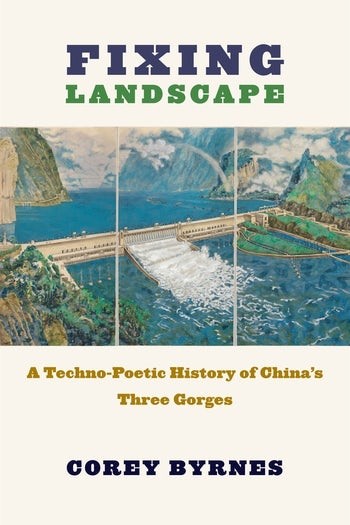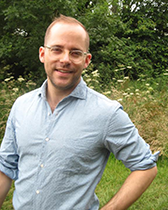WEAI Author Q&A: Corey Byrnes' “Fixing Landscape”

We are excited to announce a new title in the Studies of the Weatherhead East Asian Institute book series: Fixing Landscape: A Techno-Poetic History of China’s Three Gorges, published by Columbia University Press. The book’s author is Corey Byrnes, an Assistant Professor Modern Chinese culture at Northwestern University. Dr. Byrnes was the co-winner of the Weatherhead East Asian Institute’s 2018 First Book Prize for Fixing Landscape.
In 1994, workers broke ground on China’s Three Gorges Dam. By its completion in 2012, the dam had transformed the ecology of the Yangzi River, displaced over a million people, and forever altered a landscape immortalized in centuries of literature and art. The controversial history of the dam is well known; what this book uncovers are its unexpected connections to the cultural traditions it seems to sever. By reconsidering the dam in relation to the aesthetic history of the Three Gorges region over more than two millennia, Fixing Landscape offers radically new ways of thinking about cultural and spatial production in contemporary China.
Corey Byrnes argues that this monumental feat of engineering can only be understood by confronting its status as a techno-poetic act, a form of landscaping indebted to both the technical knowledge of engineers and to the poetic legacies of the Gorges as cultural site. Synthesizing methods drawn from premodern, modern, and contemporary Chinese studies, as well as from critical geography, art history, and the environmental humanities, Byrnes offers innovative readings of eighth-century poetry, paintings from the twelfth through twenty-first centuries, contemporary film, nineteenth-century British travelogues, and Chinese and Western maps, among other sources. Fixing Landscape shows that premodern poetry and visual art have something urgent to tell us about a contemporary experiment in spatial production.
We thank Dr. Byrnes for taking the time to discuss his book with us. Please read the following Q&A to learn more about the research and questions that drove his project.
How did you become interested in studying the cultural meanings of China’s landscape, particularly the Three Gorges, during graduate school at U.C. Berkeley?
Like so many things, this project came about more or less accidentally. I’ve always felt deep connections to certain landscapes, especially the New England landscapes I grew up in, but I didn’t enter graduate school with a plan to study landscape, the Three Gorges, or cultural approaches to environmental issues. What led me to this project and to my interest in the relationship between aesthetic and material landscapes was a strong desire to juxtapose two very different works—the Tang Dynasty poet Du Fu’s monumental “Autumn Stirrings” sequence, from the mid-eighth century, and Jia Zhangke’s film Still Life, from 2005. My relationship with both of these works began in my first year at Berkeley, though it took me a few years to realize that I wanted to bring them together in a single project that breached what can still sometimes feel like a strong pre-modern/modern divide in Chinese studies. My dissertation and then my book were really designed around making this juxtaposition work; not just covering the intervening 1200 years, but thinking rigorously about the role of cultural production in making the Three Gorges a famous landscape that signifies in remarkably similar, but never identical, ways across time.
What are some of the questions that have been central to your research and teaching and how do they relate to Fixing Landscape? What does the term “techno-poetic” mean and how do you see the construction of the Three Gorges Dam as a techno-poetic act?
One thing that’s really driven my first book project is an interest in the relationship between how we imagine and represent the physical world and what we do in and to it. It’s easy to identify links between technical representations such as maps and blueprints and how humans have reshaped the world to suit their needs. What’s harder to describe is how forms that seem strictly representational (“merely” literary or visual) constitute spatial practices with real material effects. An important argument in my book is that pre-modern Chinese landscape writing has very little to do with anachronistic but popular formulae such as “traditional Chinese ideas about nature” or “pre-modern Chinese ecological consciousness.” Instead, the prestige accorded certain kinds of writing and image making created such a strong virtual sense of place that pre-modern scholars who actually travelled to the Three Gorges or other famous landscapes ended up spending a great deal of time comparing what they saw with what they had read. In some cases, those with the means went so far as to alter the physical landscape to better match poetic ones. It’s in moments of landscape-inspired landscaping that the poetic overlaps with the technical, hence the term “techno-poetic” in the book’s title. Ultimately, my goal is not to exaggerate the link between Tang poetry and the Three Gorges Dam project, but rather to show that the former is not just an emblem of “Chinese tradition” and that the latter is far more than just a monumentally destructive engineering project. In my dissertation, I still conceived of the dam as having shattered a fundamental connection between a primary physical landscape and the secondary aesthetic culture it had inspired. What I came to see more clearly in the course of preparing the book is not just that the dam is an aesthetic object in its own right, but also that the physical landscape does not necessarily precede the aesthetic one.
How did you first go about conceiving and organizing a book project that would span 1,200 years of Chinese environmental, cultural, and artistic history?
As I explained above, the idea for the project came out of a juxtapositional instinct that I have tried to develop into a juxtapositional method. To be honest, however, when I started out, I didn’t really know what I was getting myself in to. It’s not easy covering this much ground (the earliest material in the book goes back well over two millennia), and I wouldn’t necessarily recommend it to dissertation writers! The historical span was possible for two reasons: First, I quickly gave up any hope of being exhaustive, whether in terms of historical coverage or available materials. Instead, I choose key moments, figures, texts, images, and sites that I consider especially important to the techno-poetic history of the Three Gorges region that I wanted to tell. I still get anxious when I think about what got left out of the book —and I’m sure people will look for things that aren’t there — but a selective approach was the only realistic option.
The other thing that made the historical span possible is that I started graduate school as a pre-modernist working on medieval Chinese literature and only transitioned to working on modern and contemporary China a few years in. I was lucky to be able to draw on years of training in classical Chinese language and literature, though my approach to pre-modern materials is now, admittedly, somewhat unorthodox. One of the things that really motivated me at first was my frustration with how some scholars of contemporary Chinese film and literature described the role of “traditional” aesthetics in new works. I wanted to see if it was possible to read contemporary and pre-modern sources in tandem, to place them in their historical and cultural contexts while also seeing what they might say to one another, how they might resonate in new ways when placed side by side. This is why, although the book as a whole is arranged in roughly chronological order, individual chapters tend to move freely between works from different periods.
What challenges did you encounter in the course of your research and writing?
I think one of the hardest things about turning a dissertation into a book is figuring out how to repurpose all of the writing and research you’ve already done when your argument and the overall shape of the project is in the process of changing. The two years I spent researching and writing two entirely new chapters on the remapping and reconceptualization of the Three Gorges from the mid-nineteenth through mid-twentieth centuries were challenging, but not nearly as challenging as trying to reconceive and rewrite chapters I produced in graduate school. Beyond that part of the process, the primary challenge was in trying to produce a thoroughly researched and rigorously argued academic book that was also, to the extent possible, a creative project. The culture of the Three Gorges is incredibly rich and I have tried to approach Fixing Landscape as not just an account of that culture, but a contribution to ways of seeing and moving through the landscape.
What findings surprised you while writing Fixing Landscape?
What never ceased to surprise me was how often the connections I thought I was crafting through my juxtapositional method had already been made in the sources themselves. The last thing I want to argue is that the Three Gorges are a stable or unchanging landscape. Yet, the same landmarks (whether rebuilt, relocated, or simply fabricated after they disappeared) appear again and again in over two millennia of texts, in the writings and images produced not just by Chinese literati, but also by Western “explorers” and travelers in the nineteenth, twentieth, and twenty-first centuries. The reappearance of these sites and views is partly what makes the landscape seem unchanging, though it’s by looking carefully at how different accounts line up, or often fail to line up, that we get a sense of the dynamism of the region, of how the landscape has been made to signify in different ways, at different times, for different purposes.
Do you have advice for scholars who aspire to connect several disciplines (such as literary studies, environmental history, art history, geography) in their book projects?
The best advice, I think, is to take your time assimilating new disciplines and methods and to get comfortable with not knowing as much as you feel you should. This is no easy task in a profession where you are judged primarily by what you know and how you know it. In the words of the environmental historian William Cronon, interdisciplinary work is a fundamentally destabilizing and humbling task that can leave you “perilously unsure” of yourself. The more you reach beyond your immediate training, the further you get from anything like mastery. This is scary territory and there are plenty of pitfalls, but I still think the rewards are worth it.
Can you tell us briefly about your current research project(s)?
I’ve got a few more landscape related articles that should be coming out soon, including one on what I call the Chinese “landscape of desolation,” which will be published in Representations in the summer of 2019. I’ve also started work on my second book project, China as Threat, which combines approaches from Chinese literary and cultural studies, animal studies, and the environmental humanities to examine how familiar discourses of China as threat have been resurrected in responses to recent environmental and public health crises. The book is designed around three animal-centered case studies that place China’s intertwined environmental and public health problems in local, regional, and global contexts while also demonstrating the unpredictable relationship between imagined threats and real-world actions. By following the movement of animals, pollution, diseases, and people between China, North America, Southeast Asia, Africa, and other areas, China as Threat not only seeks to better understand the consequences of how we imagine pressing environmental problems, it also offers new ways of imagining connectedness and shared vulnerabilities across national and species boundaries. I hope to have a section of the book on pigs, swine flu, poetry, and visual culture in print before too long.

